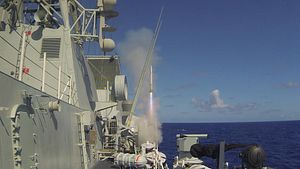This week, a Canadian warship paid a scheduled port visit to Vietnam. The visit, which came following several other such interactions involving major Asian states, highlighted Canada’s continuing efforts to boost security ties with Southeast Asian states such as Vietnam and further emphasize its role as a key defense player in the Asia-Pacific more broadly.
Although Canada has in fact been one of the longest-serving ASEAN dialogue partners, there has been a notable effort by the country to further boost its engagement with Southeast Asian states, including in the defense realm where it is a key partner on a range of issues from terrorism to disaster relief but remains left out of key political-security forums. Indeed, several defense-related activities were in focus last year tied to the 40th anniversary of Canada’s partnership with ASEAN.
Canada’s defense-related engagements with Southeast Asian states has continued into 2018, and that includes Vietnam as well. Indeed, given that this year is the 45th anniversary of diplomatic ties between the two sides, that has provided an occasion for both countries to undertake a series of engagements that are tied to that commemoration. A notable example came in June, when Defense Minister Harjit Sajjan paid the first-ever visit by a Canadian defense minister to Vietnam and both sides inked a memorandum of understanding formalizing Vietnam’s participation in Canada’s Military Training and Cooperation Program which had officially started last year.
This week, in an example of this, the relationship was in the headlines with the visit of a Canadian ship to Vietnam. The HCMS Calgary ship and the MV Asterix interim auxiliary oiler replenishment vessel of the Royal Canadian Navy arrived at the Tien Sa Port in Danang on September 26 to start a five-day visit to Vietnam that is expected to last until September 30. The visit by Canada followed a number of such visits by key Asian states in September, including a South Korean destroyer and a Japanese submarine – a notable first (See: “Why Japan’s First Submarine Visit to Vietnam Matters“).
The visit of the HCMS Calgary, a Halifax-class frigate led by Commander Blair Saltel and with around 230 personnel, was partly framed as a boost for bilateral ties. Part of the range of interactions involved meetings with Vietnamese military and political officials, with courtesy calls made to various parties including the municipal People’s Committee and the High Command of Naval Region 3. But there were other aspects as well, including events with businesses, students, disabled children and victims of Agent Orange. The highlight of the interaction is a maritime exercise between both countries.
Beyond the bilateral piece, the significance of the visit is tied to the regional angle as well. The port visit was one of eight that Canada conducted as part of Operation Projection in the Asia-Pacific to increase the presence of the Royal Canadian Navy in the region through conducting naval presence operations, supporting international naval exercises with partners, and promoting interoperability with like-minded states.
Following the visit to Vietnam, Operation Projection will continue with stops to South Korea for the International Fleet Review in Jeju, followed by Japan and then Hawaii (See: “ASEAN-South Korea Security Ties in the Spotlight at 2018 Seoul Defense Dialogue“). It is then expected to sail home to Canada in mid-December after around six months of sailing through the Asia-Pacific region.
































